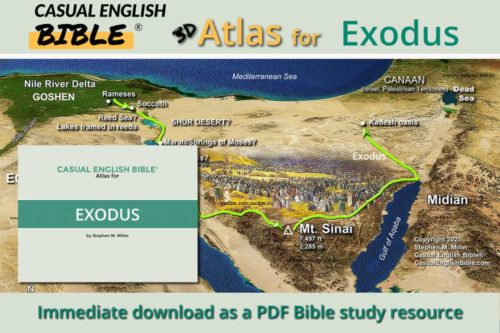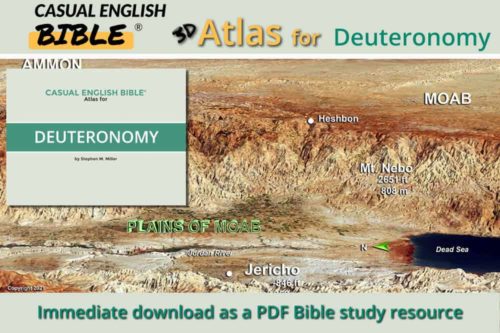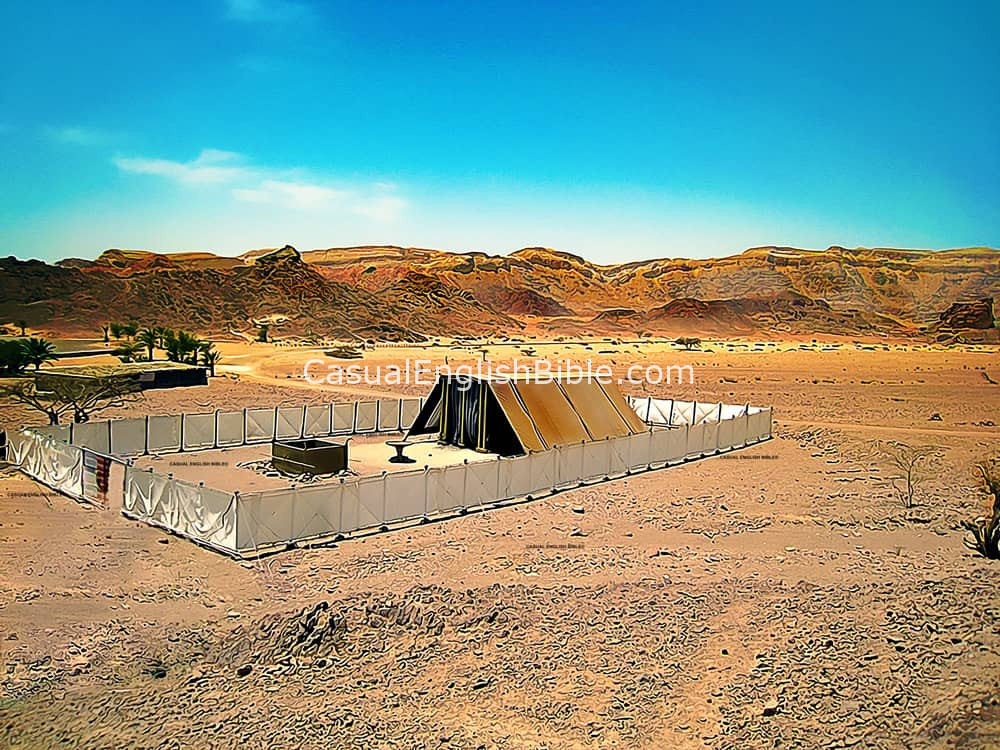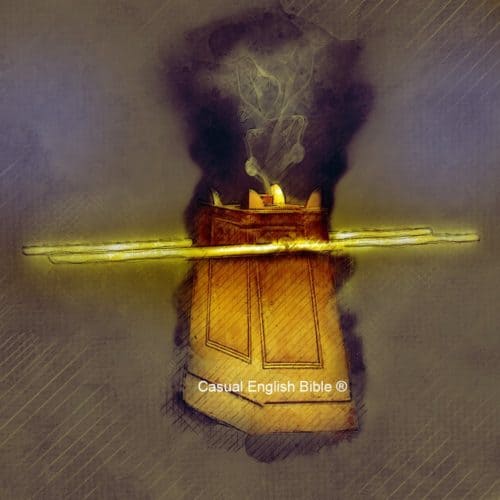Exodus 30
Worship center under construction
Building the incense altar
1“I want you to make an altar that you can use to burn incense. Make it out of acacia wood. 2Make the top into a square, 18 inches (46 cm) long and wide. It should stand 36 inches (92 cm) high. Put horns [1] at the four corners of the top. Don’t add these later. Carve them from the same piece of wood you use to make the rest of the altar. 3Cover the entire altar with pure gold, from top to bottom, including the horns. Add gold decorative molding around the altar. 4Make two golden rings for the altar. Put them under the molding on opposite sides of the altar. When you need to transport this altar, you’ll slip poles through these rings and carry the altar that way.5Make those poles out of acacia wood, and cover them with gold. 6Put this altar in front of the curtain that blocks off the Most Sacred Room, which contains the box that holds the Ten Commandments. The lid covering that box is where I will meet with you. 7I want Aaron to burn scented incense on this altar every morning, when he takes care of the oil lamps. 8I want him to burn incense again at dusk, when he adjusts the lamps for nighttime. This is something I want you to continue doing throughout the generations.
9This is not an altar for just any incense. Burn only the incense I approve. And don’t offer anything else on this altar. Not animals or grain or liquid. 10Once a year I want Aaron to purify this altar with blood from an animal sacrificed to pay for sins. [2] Aaron will put this blood on the horns of the altar. The LORD considers this a very sacred practice, and you are to continue it throughout the generations.”
Census fee to save your lives
11The LORD told Moses, 12“When you take a census of the people of Israel, I want you to collect a fee from each one. This will protect them from a plague that could strike them because they conducted a census. [3] 13The fee everyone needs to pay as a contribution to the LORD is half a shekel. And I’m talking about the kind of shekel weight in coins given for the worship center. [4] 14Everyone who is age 20 and older must pay this fee as a contribution to the LORD.15Rich people don't have to pay more. Poor people don't get to pay less. It's half a shekel. Period. When you make this contribution to the LORD, you’re putting yourself on good terms with the LORD. 16Take this money you collect and use it to maintain the tent worship center. This will serve as a constant reminder that the people of Israel have made the contribution the LORD required and that they are on good terms with him."
A big bronze bowl for washing
17The LORD told Moses, 18"I want you to make a large bronze bowl with a bronze base. You’ll use this bowl to hold water you’ll need for washing. Put it in the courtyard of the worship center, between the altar and the tent sanctuary. 19Aaron and his sons will use this water to wash their hands and feet. 20If they don't want to die, they’ll wash with water before they approach the altar to offer a sacrifice or before they step inside the tent sanctuary. 21To be clear, they are going to wash their hands and feet so they don't die. I’m making this a rule permanent. It applies to Aaron and all of his descendants to come."Recipe for anointing oil
22Again, the LORD talked to Moses. 23"I want you to make a gallon (4 L) of holy oil from these ingredients:12 pounds (5.7 kg) of liquid myrrh [5]
6 pounds (2.9 kg) of fragrant cinnamon
6 pounds of aromatic cane
2412 pounds of cassia.
Use the measure of weights that you use in the worship center. Mix it all into a gallon (4 L) of your best olive oil.
25Like a skilled perfumer, turn this fragrant mixture of ointments into a sacred anointing oil. 26Then use this oil to anoint the tent worship center. Also anoint the box that contains the Ten Commandments. 27Anoint the table inside the tent sanctuary, along with its utensils, and the lampstand with its utensils, and the altar that you use to burn incense. 28Anoint the altar where you burn sacrificial offerings. And anoint all the utensils used in offering sacrifices, including the bronze bowl and its stand. 29I want you to consecrate all of these, which will devote them to me and make them so sacred that anyone who touches them will become holy.
30Anoint Aaron and his sons, and dedicate them to me so that they can minister as my priests. 31I want you to tell the people of Israel, 'This recipe for oil is reserved for the LORD throughout the generations. 32You're not to make oil like this to pour on your body. This is holy oil, intended to purify you and enable you to come to me in worship, and to be acceptable in my eyes. 33Kick out of the community anyone who uses this recipe to make this oil and then puts it on someone who is not a priest.'"
Recipe for incense
34The LORD told Moses, "I want you to make incense from these aromatic spices and herbs: stacte, [6] onycha, galbanum, [7] and pure frankincense. Mix them together in equal parts. 35Like a skilled perfumer, mix everything together into a fragrant incense. Add salt to purify it into holy incense. 36After you mix the ingredients, crush some of the mixture into powder and then put the powder on the incense altar in front of the box that holds the Ten Commandments. That’s where I meet with you inside the worship center. 37Do not use this recipe to make incense for yourself. It is reserved for the LORD. This incense is holy. 38People who use this recipe to make incense for themselves should be kicked out of the community.”Footnotes
Archaeologists have uncovered many “horned altars” in Israel and Palestinian Territories. Bible writers never explained why altars were built with the corners turned up like animal horns. On large altars, where animals were sacrificed, horns may have been a tribute to the livestock sacrificed there. One more common guess is that the horns gave priests something to which they could tie the dead animal. This could help keep the sacrificed animal from rolling off the fire before it was burned. Psalm 118:27 seems to add credibility to that theory: “Go ahead and tie the festival sacrifice to the four corners of the altar.” In this case, however, horns may simply have been a reflection of the main sacrificial altar
The high priest did this once a year on the Day of Atonement, usually in September or October. Jewish people today call it Yom Kippur. This is the holiest day on the Jewish calendar, a day of nationwide repentance for sins committed during the past year.
It’s unknown why a census would warrant a plague. But that’s exactly what happened when King David took a census (2 Samuel 24; 1 Chronicles 21). Some scholars guess that it has to do with pride and with counting an army to see how strong the people are. Given that God has been the one doing all the heavy lifting during the Exodus, it might seem insulting for the people of Israel to count the men who could fight in the militia or an army, when God was doing the fighting for them. Others suggest the fee might have been an attempt to turn attention away from warfare and toward worship. Money gathered from counting soldiers in an army ended up going to support the worship center. That would be a bit like taking some money from a nation’s defense budget and redirecting it to places of worship.
Shekels came in different kinds of metal and different weights. It’s unclear what kind of shekel the writer was describing, or how much it weighed. There was a heavy shekel that weighed about 11.5 grams or .4 ounces. This was sometimes called the King’s Shekel or the Royal Shekel. Some scholars say this was also the weight used in the Israelite worship center and later in the Jerusalem Temple. The lighter shekel weighed about 9.5 grams or .33 ounces. Some scholars say this was probably the shekel accepted at the worship center.
Myrrh and frankincense (Exodus 30:34) were two of the most exotic and expensive fragrances available. They were made from sap of small trees and shrubs growing in what are now Saudi Arabia, northern Africa, and India. People would grind up the dried sap and put it in perfumes. They also burned it as a woody fragrance, and a sweet-smelling incense. They burned the incense in religious services. They also burned incense in homes as air fresheners in the days before soap and deodorants.
Uncertain what stacte or onycha were. Possibly from some tree sap or juices pressed from flowers or other plants.
Sap from the stem of a flowering plant native to northern Iran: Ferula gummosa.
Discussion Questions
- Sorry, there are currently no questions for this chapter.









